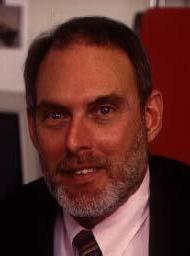
Spring/Summer 1999
Volume 6, Issue 2
Spring/Summer 1998
Volume
3, Issue 1
January 1995
Volume
2, Issue 4
October 1994
Volume
2, Issue 1
January 1994
EAC FOCUS

Sid Karin
Director, San Diego Supercomputer Center; Adjunct Professor, Computer
Science and Engineering, University of California at San Diego; Vice
President, Advanced Computing , General Atomics; and General Conference
Chair, SUPERCOMPUTING '95
Sid Karin earned his B.E. in Mechanical Engineering from the City College of New York, and his M.S.E. and Ph.D. in Nuclear Engineering from the University of Michigan, after which he embarked on a career in computer programming and engineering at General Atomics, San Diego, in 1973. A registered professional engineer, Karin held several engineering and management positions there before becoming founder and director of the San Diego Supercomputer Center (SDSC) in 1985. Karin has been an adjunct professor of Computer Science and Engineering at the University of California at San Diego since 1986.
Karin's research interests include scalable parallel and distributed computing, high-speed networking, archival storage, scientific visualization, and, more recently, security. "SDSC's new initiative in security, " says Karin, "leverages some previous work in active attack analysis by senior fellow Tsutomu Shimomura and security analyst Andrew Gross. The importance of their work was brought to the nation's attention in February of this year when they helped the FBI locate and arrest fugitive computer criminal Kevin Mitnick."
Currently, Karin is Principal Investigator for the National Biomedical Computation Resource (NBCR). "NBCR's main goal," says Karin, "is to move biomedical researchers onto scalable parallel computers to further their work in a broad range of scales from the atomic to the cellular levels."
Karin points out that he is also co-PI for the Collaboratory for Microscopic Digital Anatomy (CMDA). "The Internet offers new opportunities for remote access to centralized, expensive instrumentation," he says. "CMDA will provide such access to an intermediate-voltage electron microscope to support new insights into biological structure and function."
As SUPERCOMPUTING '95 Chair, Karin brings more than two decades of professional experience in computer science, engineering, research, and management to the leadership of this widely attended, eighth annual high-performance computing conference. "One of the things we're the most excited about," says Karin, "is the network we're designing and installing for the conference. Normally, presenters and exhibitors are constrained by the technology of the convention center where the conference is held. This year, we're challenging their imaginations to take full advantage of the new capabilities we'll be providing. They will be able to use the most advanced network ever constructed for a conference, which we believe will forever change how future high-tech conferences are run."
Karin is also a member of the Federal Networking Council Advisory Committee and the Jet Propulsion Laboratory Center for Space Microelectronics Technology Advisory Panel. His honors include an Atomic Energy Commission Special Fellowship in Nuclear Science and Engineering, National Defense Education Act Fellowship, New York State Regents College Scholarship, and Outstanding Alumnus, University of Michigan Nuclear Engineering Department.
As a member of the CRPC External Advisory Committee, Karin believes that the CRPC plays a critical role in the computational community's efforts to advance computing technology. "The CRPC is making parallel computers useful for a broad range of the nation's scientists," he says.
Table of Contents